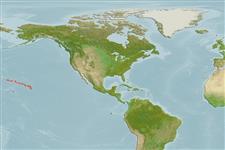分類 / Names
俗名 | 同種異名 | Catalog of Fishes(屬, 種) | ITIS | CoL | WoRMS | Cloffa
Teleostei >
Acanthuriformes (Surgeonfishes)
鱸形目 (Surgeonfishes) >
Chaetodontidae (Butterflyfishes)
蝴蝶魚科 (Butterflyfishes)
Etymology: Chaetodon: Greek, chaite = hair + Greek, odous = teeth (Ref. 45335).
Environment: milieu / climate zone / depth range / distribution range
生態學
海洋 礁區魚類; 非遷移的; 深度上下限 5 - 114 m (Ref. 58302). 熱帶
Eastern Central Pacific: Hawaiian Islands and Johnston Atoll.
中太平洋東部: 夏威夷群島與詹斯頓島環礁。
大小 / 重量 / 年齡
Maturity: Lm ? range ? - ? cm
Max length : 12.0 cm TL 雄魚/尚未辨別雌雄; (Ref. 9710)
背棘 (總數) : 13 - 14; 背的軟條 (總數) : 23 - 26; 臀棘: 3; 臀鰭軟條: 18 - 20.
Benthopelagic over reefs and rocks (Ref. 58302). Feed mainly on coral polyps, also polychaete worms and small shrimps. Usually seen in pairs. Oviparous (Ref. 205). Form pairs during breeding (Ref. 205).
主要吃珊瑚蟲, 也多毛類的蠕蟲與小的蝦。 通常成對被見到。
Life cycle and mating behavior
Maturities | 繁殖 | Spawnings | Egg(s) | Fecundities | 仔魚
Form pairs during breeding (Ref. 205). Monogamous mating is observed as obligate, genetic and social (Ref. 52884).中太平洋東部: 夏威夷群島與詹斯頓島環礁。
Randall, J.E., 1985. Guide to Hawaiian reef fishes. Harrowood Books, Newtown Square, PA 19073, USA. 74 p. (Ref. 3921)
人類使用
漁業: 商業性; 水族館: 商業性
工具
特別的報告
下載 XML
網路資源
Estimates based on models
Preferred temperature (Ref.
123201): 15.1 - 25.5, mean 20.3 °C (based on 4 cells).
Phylogenetic diversity index (Ref.
82804): PD
50 = 0.5000 [Uniqueness, from 0.5 = low to 2.0 = high].
Bayesian length-weight: a=0.02630 (0.01411 - 0.04903), b=3.04 (2.88 - 3.20), in cm total length, based on LWR estimates for this species & Genus-body shape (Ref.
93245).
營養階層 (Ref.
69278): 3.3 ±0.0 se; based on diet studies.
回復力 (Ref.
120179): 高度, 族群倍增時間少於 15個月 (Preliminary K or Fecundity.).
Fishing Vulnerability (Ref.
59153): Low vulnerability (10 of 100).
Nutrients (Ref.
124155): Calcium = 125 [63, 197] mg/100g; Iron = 0.957 [0.555, 1.659] mg/100g; Protein = 18.5 [17.3, 19.7] %; Omega3 = 0.139 [0.077, 0.248] g/100g; Selenium = 44.9 [22.7, 86.3] μg/100g; VitaminA = 47 [13, 175] μg/100g; Zinc = 1.63 [1.08, 2.38] mg/100g (wet weight);
